Who Invented Cable TV?
So we are now roughly into 1948, the same year in which Ed Parsons in Oregon, John Walson in Pennsylvania, and Jim Davidson in Arkansas appeared with RF distribution from a master antenna to connected homes. One of these three would seem to be the creator of the American CATV (community antenna television) concept.
But well after 1948, other claimants would surface.
Oral Histories
Oral Histories (or Aural Histories, as they're sometimes called) are an important part of the historical record. Recorded oral history interviews can be distributed as audio recordings or digital audio files, or they can be transcribed to text for distribution as digital text files or paper documents.
Oral history interviews are the source of some of the information cited in this narrative. These oral histories have come from two sources:
| |
Mary Alice Mayer Phillips (née Mayer). In 1968-72, Phillips was a doctoral candidate in the Graduate School of Northwestern University, Evanston, Illinois. For her thesis topic she chose the history of what was then known as "community antenna television." During the course of her research, she conducted oral history interviews with several prominent industry pioneers including system operators, equipment manufacturers, and journalists.
 In 1972, Phillips revised and updated her research for publication in book form. The resulting book, CATV: A history of Community Antenna Television, was published by Northwestern University Press in 1972. In the book she frequently quotes from the oral history interviews.
In 1972, Phillips revised and updated her research for publication in book form. The resulting book, CATV: A history of Community Antenna Television, was published by Northwestern University Press in 1972. In the book she frequently quotes from the oral history interviews.
This book stands today as one of the most important primary sources for information about the early history of the cable television industry. According to a review by Louis Harris, published in Performing Arts Review in 1973, "Miss Phillips has done the first primary work in the field."
The Cable Center.
The Barco Library at The Cable Center has compiled a large collection of oral histories known as the Hauser Oral and Video Collection. Most of these interviews were recorded after 1985, when The Cable Center was founded. Interviews were conducted by various interested parties including Mary Alice Mayer.
|
The following interviews are relevant to this narrative:
• Davidson 1999 (Barco Library, 1999).
Interviewed by Jim Keller.
• Parsons 1986 (Barco Library, 19-Jun-1986)
Interviewed by Richard Barton.
• Walson 1968 (Private, 23-Nov-1968)
Interviewed by Mary Alice Mayer.
• Walson 1970 (Barco Library, 21-Jul-1970)
Interviewed by Mary Alice Mayer.
|
So what is a CATV system?
That is the real question here. The answer depends on the definition of "CATV". Here's one possible definition — a CATV system must meet the following criteria:
Utilizes one or more (possibly multiplexed/diplexed receiving) antenna(s).
Feeds a single output cable, with or without in-line amplifiers.
Reaches two or more subscribers who pay a monthly or annual fee.
If a system meets all of these criteria, the list would be long even in 1949, and by 1950 it would fill pages.
This definition ignores the finer points such as coaxial cable. As we have already noted, twinlead was not, in the American terminology, the same as cable, although it might have been in the UK ("wires covered in plastic").
This definition also ignores the distinction between a CATV system and an MATV (or SMATV) system. Here in the United States, a CATV system, simply because it occupies public right-of-way, is subject to numerous legal requirements that do not apply to MATV and SMATV systems. This distinction is rooted in FCC rules and regulations dating as far back as 1976:
| §76.5(a) [The term] cable television system ... shall not include ... any such facility that serves or will serve only subscribers in one or more multiple unit dwellings under common ownership, control or management. ( 47 CFR §76.5(a) 1976) |
And reaffirmed as recently as 2011:
| §76.5(a) [The term] cable television system ... does not include ... a facility that serves subscribers without using any public right-of-way. (47 CFR §76.5(a) 2011) |
In the timeframe of the present narrative (1948-50), these definitions did not exist (the FCC did not assume authority to apply any regulations to the CATV industry until the 1960s). Nevertheless, for the purpose of this narrative, we will accept the FCC's distinction and concentrate our discussion on CATV systems as subsequently defined by the FCC. Accordingly, we define a CATV system as a system that meets the following criteria:
Utilizes one or more (possibly multiplexed/diplexed receiving) antenna(s).
Feeds a single output cable, with or without in-line amplifiers.
Is entirely shielded by the use of coaxial cable and properly shielded components.
Reaches two or more subscribers who pay a monthly or annual fee.
Occupies public streets (right-of-way) in at least one location.
Who got there first?
Having agreed on a working definition for "CATV," we now turn attention to the historical question: Who was the first person to build a cable TV system meeting the above definition?
There are three recognized contenders:
Jim Davidson in Tuckerman, Arkansas
Leroy "Ed" Parsons in Astoria Oregon.
John Walsonovich (later Walson) in Mahanoy City, Pennsylvania
By the late 1980s, all three (and others) were being hounded by would-be historians who were searching for the holy grail — "the first one".
As noted in the adjacent sidebar, much of the research into the early history of CATV was the work of Mary Alice Mayer Phillips, a doctoral candidate at Northwestern University and the author of the book CATV: A history of community antenna television. According to Phillips, Parsons was a reluctant participant in this contest. Walson claimed to have been first, and focused heavily on the recognition he believed came with being first. Davidson was more casual but no less precise in reciting his own credentials for the honor.
Thomas P. Southwick, in his book Distant Signals, mentions all three contenders, but concludes that Davidson was the winner.
These authors, and others, attempted to define this trail before I completed research for this narrative. I believe they lacked a measure of objectivity. Furthermore, they lack an important ingredient: they were not there, active, in the early era. For most of it (1950 onward), I was.
With that in mind, here's what my research tells me.
JAMES DAVIDSON
Jim Davidson in Tuckerman, Arkansas had one paying 'antenna system subscriber' but the timeline of when that subscriber ― Carl Toler ― became a 'paying CATV subscriber' is blurred. Like many other CATVs of the day, Davidson's CATV system carried only one channel ― in this case, WMC-TV, Memphis.
But this story begins even before WMC-TV first went on the air.
In anticipation of the day when WMC-TV (later WMCT) would first sign on, Davidson erected a 100-foot tower on the roof adjacent to his appliance store (some 100 miles from the WMC-TV transmitter), added a channel 4 yagi antenna and a booster amplifier and waited for the station to sign on. He was going to be the first person in Tuckerman with television — and he was. But WMC-TV, while it was routinely testing in the fall of 1948, did not officially begin programming until December 1948.
In October 1998, Davidson published a memoir titled 50th Anniversary "to honor the 50th anniversary of my first subscriber." A PDF copy is posted here. (Davidson 1998)
Here is the chronology of events based on our research:
-
October 17, 1948: Davidson connects his antenna to Carl Toler's home. (Davidson 1998. p.6.). According to Davidson's oral history interview, Toler "was the local depot agent and telegrapher... He was extremely interested in television." (Davidson 1999, ¶56).
- Date unknown: WMC-TV begins test broadcasts.
- November 13, 1948: WMC-TV broadcasts a football game between the Universities of Tennessee and Mississippi. According to Davidson, "The Tolers said that their living room had standing room only, for this football game. The American Legion building was standing room only. My shop and store were standing room only." (Davidson 1999, ¶56).
-
December 11, 1948: WMC-TV commences regular programming. (Wikipedia)
Although Davidson's claim to have received WMC-TV's signal is further supported by area newspaper accounts prior to December 1948, his claim is tainted by the 'test status' of WMC-TV at the time. The only test transmission that seems to work in his favor is the November football game.
At what point would his single customer actually have begun paying for the connection to the antenna? Prior to the start of daily programming on December 11th? Was the test pattern reason enough to routinely pay Davidson for 'sharing' his antenna? He notes that he "later charged $150 for the installation and $3 a month." When was "later"? The Davidson evidence does not answer this question.
LEROY "ED" PARSONS The Parsons story, largely because of the root work done by Mary Alice Mayer Phillips in her 1972 book, is well documented in Southwick's book even if his portrayal of Astoria lacks important detail. Although Davidson spoke up late, his records (dated receipts, photos, local newsprint stories) largely confirm his claims even if one paying subscriber seems a bit of a stretch.
Yet it is apparent that both Parsons and Davidson were 'ready and waiting' for the first sign of a test pattern. Davidson's claim is based on his initial attempts to receive WMC-TV. Parsons makes no such claim before the actual first-day broadcast, but his oral history (Parsons, 1986) and Phillips' book both clearly show that he began searching for, and actually identified, KRSC-TV's transmitter test signals as early as September 1948. Davidson counts a test pattern to support his claim, whereas Parsons waited for actual programming. In a technical sense, reception of a test pattern would be 'television,' but Parsons, the owner/operator of AM radio station KAST (Astoria), did not classify it as 'programming'.
While Davidson was anxious — even driven — to be recognized as 'first,' Parsons didn't even try. He left his cable activity in 1953 and never looked back. He moved to Alaska where he pioneered two-way radio systems (see 'Parsons Addendum).
If Parsons didn't try to claim the "I was first" honor, the residents of Astoria certainly did. Local civic boosters have been claiming the honor ever since. In May 1968, they dedicated a granite monument near the Astoria Column at the top of Coxcomb Hill. Text on the monument reads as follows:
|
CABLE TELEVISION WAS INVENTED AND DEVELOPED BY L.E. "ED" PARSONS ON THANKSGIVING DAY, 1948. THE SYSTEM CARRIED THE FIRST TRANSMISSION BY KRSC-TV, CHANNEL 5, SEATTLE. THIS MARKED THE BEGINNING OF CABLE TV.
|
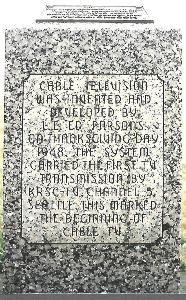 Photo: Neal McLain
Photo: Neal McLain
Front side of the monument.
| |
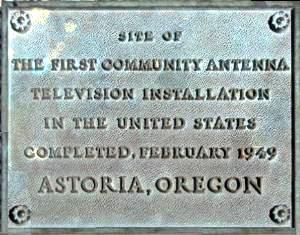
Photo: Neal McLain
Bronze plaque atop the Parsons monument
| |
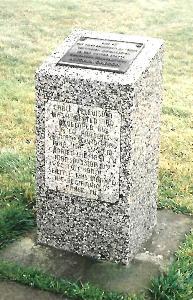 Photo: Neal McLain
Photo: Neal McLain
The Parsons monument. |
Those who might rush the process of historical discovery and verification would have made up their minds: Ed Parsons "was first." Perhaps. We'll return to this monument presently, but at this point, we will note that this plaque, atop Coxcomb Hill at an elevation of 595 feet above sea level, was not the site of Parson's first system antenna site. In fact, Parsons never had an antenna site here.
Editor's note: KRSC-TV, Channel 5, Seattle, began broadcasting on November 25, 1948, becoming the first television station in the Pacific Northwest. The first broadcast on channel 5 was a live remote of a Thanksgiving Day high school football game. In May 1949, KRSC-TV and its sister radio station KRSC-FM were purchased by King Broadcasting Company and the station's callsign was changed to KING-TV to match its radio sister. (Wikipedia). Subsequently, callsign KRSC-TV was assigned to Rogers State College, Claremore, Oklahoma, for ite television station. In 2013, after the college was renamed Rogers State University, the staton's callsign was change to KRSU-TV, branded as RSU-TV. (Wikipedia) As of this writing, callsign KRSC-TV remains unused.
JOHN WALSON Walson's claim is another matter.
Mary Alice Mayer conducted two oral history interviews with Walson:
• Walson 1968, private interview, 23-Nov-1968. No transcript is known to exist.
• Walson 1970, private interview, 21-Jul-1970, subsequently posted in the Barco Library Hauser Oral and Video Collection. A searchable transcript is available here.
Inasmuch as a transcript of the 1968 interview is not available, we will base this discussion on the 1970 interview.
Mahanoy City, Pennsylvania is a borough located in the mountainous anthracite coal-mining regions of the state. It lies in the Mahanoy Creek valley at an elevation of 1240 feet, about 79 miles northwest of Philadelphia. (Wikipedia.)
Mahanoy City is surrounded on all sides by Mahanoy Township, a constituent township of Schuylkill County. Broad Mountain, a ridge extending across the entire county, lies immediately south of Mahanoy City. Broad Mountain rises to an elevation exceeding 1700 feet, effectively blocking radio and television signals from reaching Mahanoy City. However, township residents living on top of Broad Mountain are able to receive Philadelphia television stations with rooftop antennas.
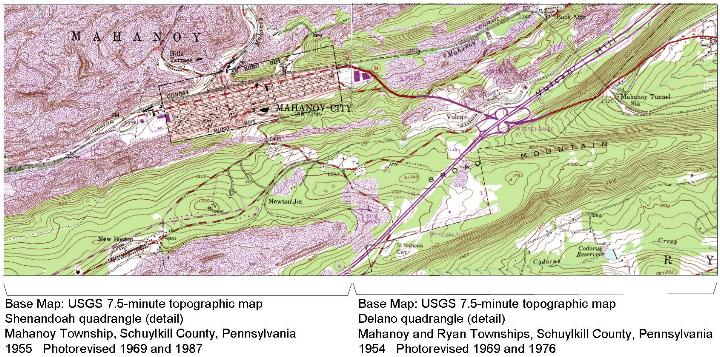 Topographic map of the Mahanoy City area. Broad Mountain is the forested ridge extending across the map south of Mahanoy City. Note the "TV Tower" on a 1700-foot peak atop Broad Mountain, directly south of Mahanoy City between New Boston and Newton Junction. Click the map for a larger view. The footprint of the tower site and the access road can still be seen on Google satellite today.
Topographic map of the Mahanoy City area. Broad Mountain is the forested ridge extending across the map south of Mahanoy City. Note the "TV Tower" on a 1700-foot peak atop Broad Mountain, directly south of Mahanoy City between New Boston and Newton Junction. Click the map for a larger view. The footprint of the tower site and the access road can still be seen on Google satellite today.
|
In 1947, when broadcast television stations began operating in Philadelphia, Walson began selling television sets. But his only customers were township residents on the mountaintops ― potential customers living in the valley could not receive Philadelphia television stations. Even Walson couldn't receive television signals in his own store. To address this situation, he constructed an antenna tower on a 1700-peak atop Broad Mountain (see map above), and from this tower, he brought the signals of three Philadelphia television stations down to his store.
Thus began the development of what would become one of the largest cable television companies in the country. But the timeline remains uncertain.
Walson relates the story in his second interview with Mary Alice Mayer:
|
I started selling TV sets about 1947, and it became very difficult to sell TV sets in a place like Mahanoy City because Mahanoy City is a community that is completely surrounded by mountains. (¶ 4)
I started in the CATV business in June of 1948. (¶ 2)
[A] cable was run from the top of the mountain from an ordinary antenna... I essentially, in June 1948 had a broadband twin-lead system just as they have today... Those three channels were 3, 6, and 10 out of Philadelphia. (¶12)
|
But did he really have an operating CATV system in June 1948?
At the outset, consider his claim that his system was able to carry three Philadelphia broadcast stations in June 1948. FCC records confirm that all three stations were on-the-air, carrying programming, by that time:
• WPTZ (channel 3) was operating pursuant to a broadcast license dated September 16, 1941.
• WFIL (channel 6) officially began broadcasting on September 12, 1947.
• WCAU (channel 10) began commercial telecasting on May 22, 1948.
So if Walson did indeed erect his antenna system in June 1948, his claim to have carried all three stations appears to be valid. Although some authors have attempted to deny him that recognition based on WCAU's on-air date, he passes that test.
As the CATV industry grew, Walson inherited a sort of legendary status, not just for constructing an early CATV system, but also for his early use of private microwave networks to import distant broadcast signals. He constructed microwave networks to import four independent stations from New York City to his network of CATV systems in north central Pennsylvania:
• WABD (Channel 5, now WNYW)
• WOR-TV (Channel 9, now WWOR-TV)
• WPIX-TV (Channel 11, still WPIX-TV)
and occasionally
• WATV (Channel 13, now WNET)
Walson's microwave network also served another purpose. By 1972, Time, Inc. was experimenting with what was then called "Pay TV" — a non-broadcast channel that CATV operators could sell for an additional monthly charge. Time's new pay TV network was called "Home Box Office" (HBO), and Walson was HBO's first distant affiliate — an affiliate located beyond the range of HBO's own microwave network in the New York/New Jersey area.
By 1960, Walson's privately-held group of CATV systems, then known as Service Electric Cable TV Inc., was among the largest in the United States. When, by 1970, Mary Alice Mayer and other authors were attempting to document the early history of the industry, Walson's company was the largest individually-owned multi-system operator (MSO) in the United States, and his company was the single largest supporter of the National Cable Television Association (NCTA)
Yet when Mayer recorded Walson's second oral history interview, Walson's memory failed him. Perhaps we can forgive him for that. Whatever his contemporaries may thought of him, they, too, apparently forgave him. Perhaps because of his status as the NCTA's largest supporter, nobody in that organization questioned his version of events.
Nevertheless, the fact remains that Walson's "I-did-it-first-in-1948" claim is suspect. Tracing his authenticity depends upon some technical issues.
So let's restart at the top. The basic question remains: what is it that defines the first CATV system?
As noted above, our definition of "CATV" requires the system to meet the following criteria:
Utilizes one or more (possibly multiplexed/diplexed receiving) antenna(s).
Feeds a single output cable, with or without in-line amplifiers.
Is entirely shielded by the use of coaxial cable and properly shielded components.
Reaches two or more subscribers who pay a monthly or annual fee.
Occupies public streets (right-of-way) in at least one location.
If we rule out systems that did not collect any kind of 'maintenance fee,' we may be forced in a legal sense to eliminate those one-time-charge systems (e.g., early Parsons) from consideration as the first CATV system, or even as an early system.
Television Digest (the former weekly high-priced Washington-based newsletter, no longer extant) might have disagreed. TVD's publisher Albert Warren was very enamored with the entire concept of community antenna television (CATV) ― so much so that if we review his 1948 and subsequent weekly issues, we discover that he routinely identified more and more of them. Indeed, so many that, by his efforts alone, it became a generic class of 'business.' Between 1948 and perhaps 1953 or so, Warren would identify more than 200 CATV systems. Warren believed they were proliferating to such an extent that the FCC was missing an important subset of the growth of television itself.
This is where Walson and hundreds like him move into a grey zone. Walson may in fact have installed an antenna on Broad Mountain in June 1948, and out of his lowland electrical shop he may well have demonstrated television reception from Philadelphia to a community where no reasonably-costed rooftop antenna would produce reliable reception.
But he was hardly unique, even in mid-1948. Folks who lived on the hilltops, including those next door to his antenna site, would have had reliable reception from Philadelphia. The concept would have been simple to comprehend: live on a hilltop, you get TV; live in the valley and you don't. So you place your antenna on the hilltop and run some sort of wire or cable.
Any issue of Radio TV News or Radio-Craft (or word-of-mouth at the local bar) would tell you how to do it. It was not a mystery and it was not complicated.
What Walson did was to turn this hilltop antenna into a business plan. He may have erred in remembering when he did it, and what equipment he used to do it with, but the fact remains: he did it.
The company that Walson founded in 1948, now known as Service Electric Cable TV and Communications, is still in business today, and it still provides cable television service in Mahanoy City. Of course, the technical plant has been been rebuilt; nevertheless, the company is almost unique in the CATV industry for having served the same community continuously since the day it hooked up its first customer.
After Walson's death, his son, John Walson, Jr. served as president until his death in 2012. Walson Jr.'s son, John M. Walson, now serves as president (Olanoff 2012). In March 2013, Service Electric closed its Mahanoy City office as part of an effort to consolidate its operations in Humboldt Industrial Park in Luzerne County, Pennsylvania (Usalis 2013).
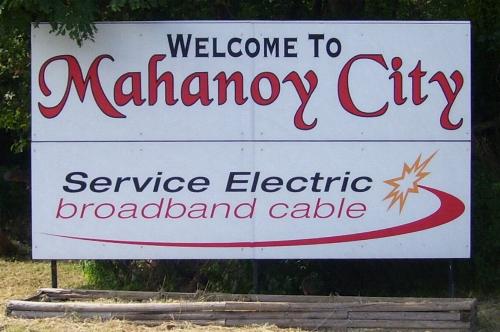
Photo: H. Antoinette Cheslock Hilmer
Advertising billboard along Pennsylvania Route 54 east of Mahanoy City
|
|
|
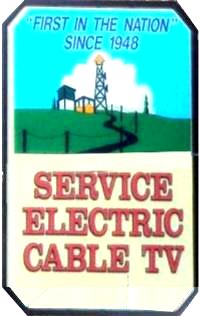
Photo: OCEM collection
Sign at Service Electric Cable TV office in Mahanoy City.
|
|
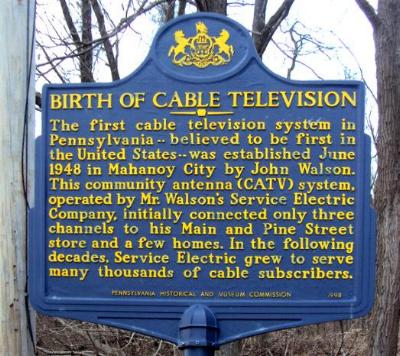 Photo: OCEM collection
Photo: OCEM collection
Pennsylvania Historical and Museum Commission marker at Mahanoy City |
Was Walson really first?
Unfortunately, there are problems with Walson's "I-was-first" claim.
In his second oral history interview (Walson 1970), Walson stated:
| |
"The cable was Army surplus, heavy duty twin lead cable that was purchased at Reliance Merchandising." (¶11)
|
This claim presents problems:
-
A thorough search of US military surplus goods offered for sale after the close of World War II reveals no 300-ohm twinlead, "heavy-duty" or otherwise, although we find several varieties of coaxial cable including RG-8/U and RG-59/U. This research also shows that something called "type 14-076 transmitting Twin-Lead" was introduced by Amphenol in 1949. It differed from "non-heavy-duty" only in its ability to handle transmitter power up to 500 watts. Other electrical characteristics, such as loss per 100 feet, were almost identical: 1.7 dB./100 feet ("heavy duty") vs. 2.0 dB./100 feet. (ARRL 1950)
- A study of more than a dozen books written and released in the 1947-51 period, each of which was created to provide technical help to radio men and electronic enthusiasts in comprehending the "new art" of television, reveals not a single mention of "heavy duty twinlead." Even Rider doesn't mention it. (Rider 1948)
- Although advertisements for "Reliance Merchandising of Arch Street, Philadelphia" appeared in contemporary issues of Radio TV News and Radio Electronics, there is no historical record of its function or product line.
|
"In June of 1948 I went to Philadelphia and bought some twin-lead cable from Reliance Merchandising, and this twin-lead cable was run from the top of the mountain from an ordinary antenna and amplified every 500 feet with a top-of-the-set booster made by Electro-Voice which is a broadband amplifier....
(¶12)
|



Photos: Lew Chandler
Electro-Voice Model 3000 Booster Amplifier. |
Our research indicates that Electro-Voice Model 3000 amplifier was not available before 1950:
The year 1950, of course, is well after the June 1948 date that Walson claims.
Parenthetically, we note that by 1950, numerous other manufacturers were making similar products. The Old CATV Equipment Museum holds several models in its collection. (Museum, p. 1122).
| |
"The amplifier only had about 6 dB. of gain...."
(¶12) |
Twinlead, "heavy duty" or not, introduces a loss of about 2 dB. per hundred feet at Channel 10 (192-198 MHz). Furthermore, the 2-dB./100-ft specification only applies to dry twinlead. Loss increases substantially if the twinlead is wet.
Setting aside the wet-twinlead problem for the moment, the loss in a 500-foot span would be five times that number, or about 10 dB., so the minimum level at the input to the second amplifier would be 10 dB. below the output of the first amplifier. Thus, each amplifier must have a minimum gain of 10 dB. at TV Channel 10.
The manufacturer's specifications for this amplifier do not specify gain. However, 6 dB. is typical for boosters of this type, so perhaps we can accept it as true. But if we accept it, the amplifier gain would have been at least 4 dB. too low to meet the 10-db./100-ft requirement noted above.
Is it possible that Walson "tweaked" the amplifiers to increase the gain to 10 dB.? Doing so might have been possible, but the manufacturer's specs don't mention it. Walson doesn't mention it either.
Furthermore, if Walson had tweaked the gain, how did it affect amplifier performance? Theoretical and experimental studies (e.g., Grant, 1998; Ciciora et al, 1999) have shown that increasing the gain of an amplifier (or, more precisely, increasing its output level), causes the distortion level to increase at a 2:1 ratio. Thus, if Walson had increased the output level by 4 dB., distortion level would have increased by 8 dB. This might have been tolerable given that the cable was carrying only three channels, but the record does not tell us.
The Radiomuseum lists known specifications for the Model 3000, but gain and output capability are not listed.
| |
I essentially, in June 1948 had a broadband twin-lead system just as they have today, 12 channels which are modern. The system was only carrying three channels, not because it wasn't capable of carrying 12 channels but because there were only three channels available. Those three channels were 3, 6, and 10 out of Philadelphia."
(¶12)
|
These would be the three Philadelphia stations we noted above:
WPTZ - Channel 3 (60-66 MHz)
WFIL - Channel 6 (80-88 MHz)
WCAU - Channel 10 (192-198 MHz)
Note that WCAU was carried on its native high-band broadcast channel; it was not downconverted to a low band channel. From the technical standpoint, this claim appears valid.
| |
I later developed the technique of building a five adjacent channel system and I had a fellow by the name of Luther Holt develop an amplifier which would develop on the low band part of the system, a commercial amplifier. That was about 1949, and that was a five adjacent channel system. (¶13)
|
If Walson had indeed constructed a working CATV network in June 1948 (as he claimed in ¶12), "about 1949" would be somewhere between six and 18 months later. During that time interval, Walson appears to have accomplished quite a bit:
-
Recruited a local electronics company owned by Luther Holt to assist with his effort. We have verified from independent sources that there actually was a CATV equipment manufacturer based in Mahanoy City and by the mid-1960s, it was producing a substantial line of CATV equipment (see Holt Addendum). The owner, Luther Holt, was a friend of Walson's, and Walson's plan to build a CATV system no doubt influenced Holt's decision to enter the manufacturing business. But we do not know when he entered the business.
- Installed a channel-converter at the tower — presumably designed and constructed by Holt — to convert the signal of Philadelphia station WCAU (Channel 10) to a low-band channel. As we noted above, Philadelphia stations WPTZ and WFIL already occupied Channels 3 and 6, leaving channels 2, 4, and 5 vacant. Any one of these channels could have been available for the downconverted signal of WCAU.
- Replaced the Electro-Voice 3000 amplifiers with new amplifiers — also designed and constructed by Holt — capable of carrying signals on all five low-band channels (Channels 2-6). He states that he accomplished this by reducing the level of the aural carrier. That technique would have worked; indeed, the same technique is still in use today for CATV networks carrying NTSC analog channels.
From the technical standpoint, these claims appear to be plausible. But the claim to have accomplished them in 1949 does not seem possible in view of the inconsistencies noted above.
So who was first?
• Davidson, who counted a test pattern as "programming"?
• Walson, who lost his records in a fire and whose memory failed him?
• Parsons, who didn't even enter the race?
Continue to Part 3...
|

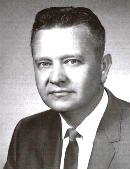 Photo:
Photo: 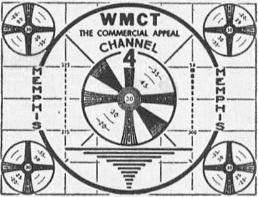
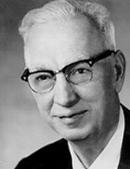 Photo:
Photo: 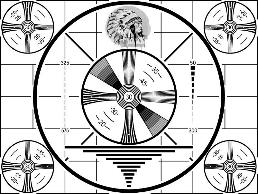
 Photo: Neal McLain
Photo: Neal McLain
 Photo: Neal McLain
Photo: Neal McLain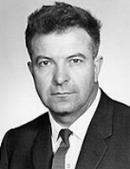 Photo:
Photo: 
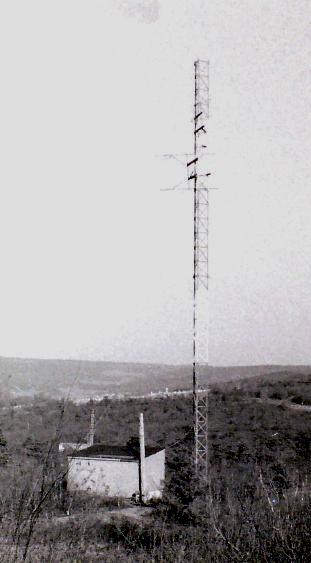 Photo:
Photo: 

 Photo:
Photo: 


